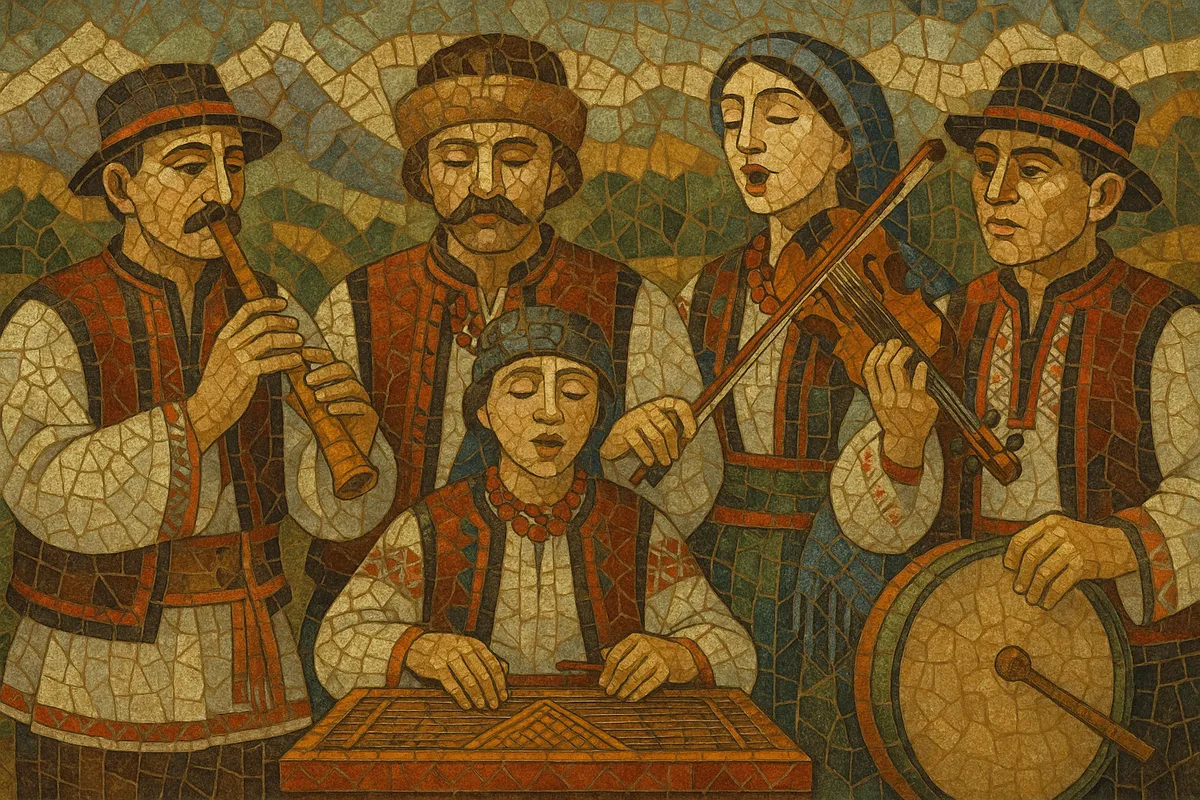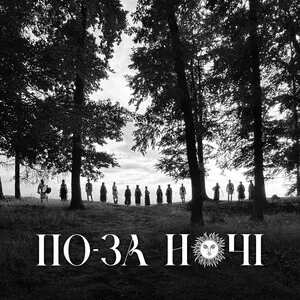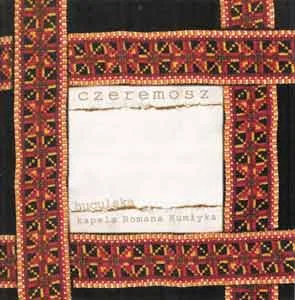Hutsul folk music is the traditional music of the Hutsuls, a highland ethnic group inhabiting the Ukrainian Carpathians (with communities across the nearby Romanian Bukovina and Maramureș). It is a lively, virtuoso village tradition centered on dances, ceremonial calls, and narrative songs that reflect mountain life, pastoral work, and the lore of the Carpathian highlands.
Its hallmark sound includes piercing trembita (long wooden alpine horn) fanfares, the ringing arpeggios of the tsymbaly (hammered dulcimer), agile sopilka/flute lines, ornamental fiddle (skrypka) leads, and earthy frame-drum (bubon) grooves, often supported by accordion and occasional bagpipe (duda) drones. Melodies tend toward modal (Dorian, Mixolydian, Aeolian) flavors, with heterophony, rich ornamentation, and shout-like “white voice” singing. Core dance types include the fast kolomyika, the elegant hutsulka, and the powerful men’s round-dance arkan.
Performed at weddings, calendrical rituals, and village festivities, Hutsul music balances social dance function with expressive storytelling—celebrating nature, love, humor, and the legendary outlaw-hero tradition (opryshky).
Hutsul folk music grew out of pastoral life in the Carpathians, where instruments such as the trembita served both musical and signaling roles. By the 18th–19th centuries, distinct village ensembles (troista muzyka) with fiddle, tsymbaly, and drum were common at weddings and fairs, accompanying core dances like kolomyika, hutsulka, and arkan.
Ethnographers and collectors in the 1800s recorded Hutsul tunes, texts, and instruments, helping codify the repertoire and ensemble practice. In the early 20th century, composers and cultural figures such as Hnat Hotkevych and Yaroslav Barnych drew on Hutsul idioms for stage and popular works (e.g., the operetta “Hutsulka Ksenia,” 1938), bringing the sound to urban audiences.
Under Soviet cultural institutions, Hutsul traditions were preserved and stylized by state ensembles (notably the Hutsuliya State Academic Song and Dance Ensemble), which promoted choreographed concert versions of village dances. Despite standardization pressures, local musicians maintained living traditions in homes, rituals, and community festivities.
Following Ukraine’s independence, field recordings, festivals, and community initiatives revitalized village practice. Contemporary groups fused Hutsul timbres with rock, ska, reggae, and experimental approaches (e.g., Perkalaba, Gutsul Calipso), while world-music acts popularized Carpathian vocal and instrumental colors internationally. This period also saw renewed appreciation for master instrument-makers and carriers of tradition in Verkhovyna and surrounding regions.
Hutsul music thrives as both a community practice and a flexible sonic identity within Ukraine’s broader folk revival. It circulates in local celebrations, academic ensembles, and global stages, retaining its core dance energy, modal color, and distinctive instrumental palette.
Start with a troista muzyka setup: fiddle (lead melody), tsymbaly (hammered dulcimer arpeggios and runs), and bubon/frame drum (groove and accents). Enrich with sopilka, floyara or tylynka (end-blown flutes), accordion, and occasional duda (bagpipe) drone. Use trembita horn calls as openings, transitions, or ceremonial codas.
Write lively dance tunes in 2/4 with strong off-beat accents and driving bass patterns. Typical forms include the fast kolomyika (8- or 16-bar phrases at ~120–160 BPM), the more graceful hutsulka (2/4 with lilting motion, sometimes leaning into a 6/8 feel), and the men’s arkan (stomping circle dance in 2/4 with shouted interjections). Keep grooves steady and propulsive for social dancing.
Favor modal pitch collections—Dorian, Mixolydian, and natural minor. Compose compact, memorable phrases with ornamental turns, mordents, slides, and appoggiaturas. Texture is often heterophonic: let fiddle and flute shadow the same melody with individual ornamentation while tsymbaly outline rapid broken chords.
Use simple, modal harmony (i–VII, i–IV–V tendencies) and pedal drones. Avoid heavy functional progressions; rely on open fifths, sustained drones (bagpipe/accordion), and rhythmic tsymbaly arpeggiation to generate harmonic momentum.
For songs, employ open-throated “white voice” in a bright, high register, with occasional shouts (e.g., “hey!”) in dance pieces. Lyrics in the Hutsul dialect often celebrate mountain landscapes, pastoral work, weddings, courtship, humor, and legendary opryshky heroes. Use short, repeatable refrains to encourage call-and-response.
Begin with a trembita or flute call, introduce the melody on fiddle, and add tsymbaly and drum. Build intensity through medleys (stringing multiple dances), gradual accelerando, and dynamic ornamentation. Maintain a danceable pulse and leave space for improvised instrumental breaks.




